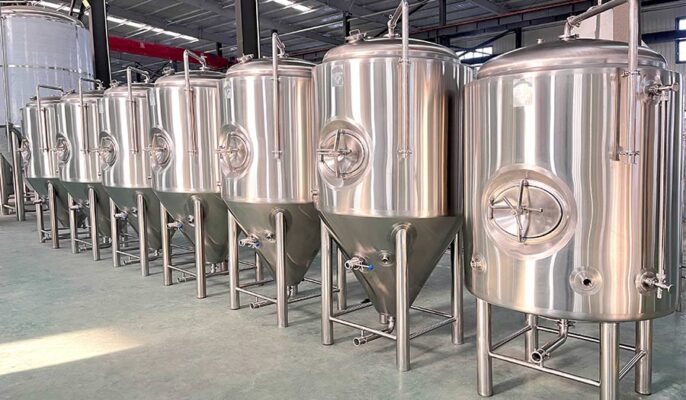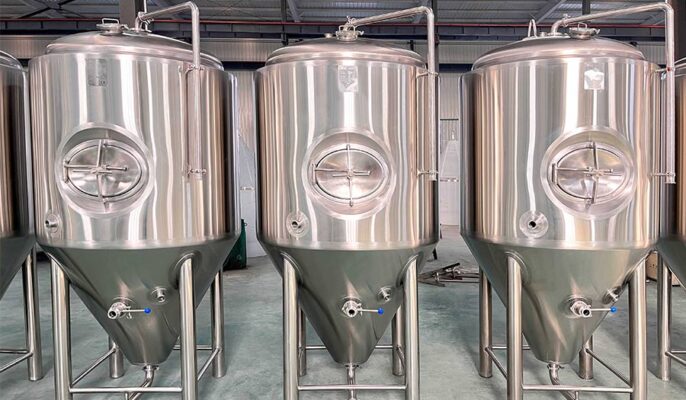A fermentation vessel (FV), or “fermenter,” is where the wort is stored while yeast ferments it into beer. It transforms wort (the sugary liquid extracted from malted grains) into a delicious and aromatic beverage that many people enjoy. As the cornerstone of the brewing process, fermenters play a vital role in cultivating the magic of fermentation. Fermenters come in many shapes and sizes and are made of different materials, with the most popular ones currently including plastic, glass, and stainless steel.
とは何か? 発酵槽?
A fermenter, also known as a fermentation tank or fermentation vessel, is a container used to hold a substrate such as wort or grape juice for fermentation. These tanks provide the necessary environment to enable yeast or other microorganisms to convert sugar into alcohol and carbon dioxide. Different products can be fermented using different yeasts in fermenters. Wort is fermented into beer using brewer’s yeast. This is because, during the fermentation process of brewing beer, yeast converts sugar into alcohol. You can also convert biomass into biogas in a fermenter.
発酵タンクの特徴:
- 材質: ほとんどの発酵タンクはステンレス鋼で作られており、耐腐食性に優れ、清掃も簡単なので、最終製品の純度と品質が保証されます。
- 温度制御: 発酵は温度に敏感なプロセスです。現代の発酵槽には、温度を調節するための冷却ジャケットまたは内部コイルが装備されています。
- 密閉環境: 汚染を防ぐために発酵タンクは密閉されています。この密閉環境により、最終製品の一貫した品質が保証されます。
- 容量: タンクのサイズは、数ガロンの小さな自家製タンクから、数千ガロンを収容できる大型の商用タンクまでさまざまです。

What is the role of fermentation tanks in brewing?
- Controlled environment: Fermentation tanks provide a sealed environment that protects fermented products from external contaminants such as wild yeast, bacteria, and airborne particles, ensuring the purity of the fermentation process.
- Temperature regulation: Many fermenters, especially closed fermenters, are equipped with temperature control systems. Maintaining the correct temperature is crucial as it affects yeast metabolism and fermentation dynamics, affecting the flavor profile and quality of the final product.
- Stirring and mixing: Some fermenters have built-in stirrers. Proper mixing ensures even fermentation, and better temperature control, and can enhance yeast health, especially in large tanks.
- Sediment separation: designed tanks, such as conical fermenters, can allow yeast and other sediments to settle to the bottom. This design simplifies the removal process and makes later filtration or racking stages more efficient.
- Carbonation: Certain fermenters, especially unit tanks, can handle the carbonation process. Once fermentation is complete, the beverage can be carbonated in the same tank, eliminating the need to transfer to another container.
ビール発酵タンクの種類
円錐形 発酵タンク
Conical fermenters are probably the most popular choice among home brewers and professional brewers alike. They have a tapered bottom that allows yeast and sediment to settle and collect at the bottom, making it easier to separate the beer from the lees (sediment) after fermentation. This design also makes it easier to harvest yeast for reuse in future batches.
平底発酵タンク
Flat-bottomed fermenters, as the name suggests, have a flat bottom and are usually made of plastic or glass. They are cheaper than conical fermenters but need extra steps to separate the beer from the sediment, such as transferring the beer to a secondary fermenter or using a siphon to remove the beer from the barrel.
円錐形発酵タンク
Conical fermenters are a hybrid of conical and cylindrical fermenters, characterized by a large cylinder with a conical bottom. These fermenters are used in commercial breweries due to their versatility, allowing fermentation and maturation to occur in the same vessel. They also help remove yeast and sediment , like conical fermenters.
Open fermenter
Open fermentation vessels are a more traditional fermentation method that exposes the fermenter to the air, allowing for natural air exchange. This method is often used with certain types of beer, such as Belgian lambics or some British ales, which enjoy the unique flavor imparted by wild yeasts and bacteria. But, open fermentation carries a higher risk of contamination and requires careful environmental control to prevent unnecessary infection.
横型ビール缶
Horizontal beer tanks are large cylindrical tanks designed for beer, which must a longer fermentation and maturation period at lower temperatures. Their horizontal orientation allows for better temperature control and easier yeast removal.
Fermenters materials
- Stainless steel material: Stainless steel is the material of choice for many commercial breweries and professional home breweries due to its durability, resistance to scratches and stains, and excellent temperature control. Yet, stainless steel fermenters tend to be more expensive than other options.
- Glass material: Glass fermentation tanks can see the fermentation process and are scratch-resistant and anti-fouling. But, they are more fragile than other materials and can break if not handled with care.
- Plastic material: Plastic fermentation tanks are lightweight, affordable, and easy to clean. But, they are more susceptible to scratches, which can harbor bacteria and lead to contamination. Additionally, some plastic fermenters may not be as airtight as other options, making them less suitable for long-term storage or aging.
- Wood: Wooden fermenters are used for certain types of beer, such as barrel-aged stouts or sour beers. Wood gives beer its unique flavor and character, but requires extra care and maintenance to prevent contamination.

Why are fermenters important in brewing?
During the fermentation process, a large amount of heat is generated, so a fermentation tank is required to maintain the proper temperature. First, add the wort to the yeast and measure the specific gravity of the mixture. A certain amount of gravity can then be measured again to find out how much alcohol is in the beer and analyze when to stop the fermentation process. The wort will be stored at 20°C for 14 days. When fermentation is complete, the yeast settles to the bottom of the conical fermenter. This conical fermenter will make it easier to remove yeast deposits for preservation and reuse during the next set of beers. While the initial investment in a good fermenter may seem high, the long-term benefits in reduced waste, consistent product quality and optimized production processes can lead to significant cost savings.
適切な発酵槽を選ぶには?
Choosing the right fermenter is important, whether you are brewing or as a hobby. This affects your production quality and efficiency. Below are some selection references, I hope they can help you.
|
CONSIDERATION POINT |
OPTIONS |
|
目的 |
Beer Brewing, Winemaking, Dairy Fermentation, etc. |
|
定員 |
5 gallons, 50 gallons, 500 gallons, etc. |
|
素材 |
Stainless Steel, Plastic, Glass |
|
デザイン |
Conical, Flat-bottom, Open-top |
|
温度管理 |
Cooling jackets, Internal coils |
|
予算 |
<$1000, $1000-$5000, >$5000 |




